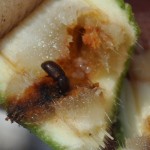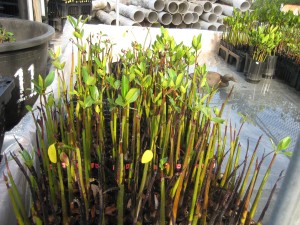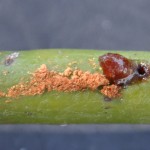by Jake Bodart

Beetle tunnel. This Scolytid beetle has burrowed into a mangrove seedling and lain its larvae inside. (Jake Bodart)
In the back of the Smithsonian Research Station here in Ft. Pierce, the mangrove team has built an artificial pond (we call it Lake Simpson) to raise mangrove seedlings that will be used in experiments. However, when we arrived here last month, we noticed that about half of the red mangroves were turning black and dying. It was unclear at first whether these mangroves were dying directly as a result of the artificial habitat (was our pond too hot? Too salty? Not salty enough?), or if the pond was somehow making the mangroves more susceptible to pest insects. We know from other studies that predation by insects can cause a large amount of propagule and seedling mortality.
Upon closer inspection, we decided insects were the culprit. The evidence of insect predation: small bore holes and little piles of frass (chewed up/excreted parts of the plant, a.k.a. insect poop). We decided to sacrifice the seedlings that were clearly infested, and dissect them to see if there were any insects inside.

Mysterious mangrove deaths. Most of the plants in this nursery are healthy, but some have turned black and lost their leaves (left and foreground). Image: Jake Bodart
By following the beetles’ tunnels through the seedling tissue, we could tell that these beetles bored in through the bottom of the seedlings and emerged through small holes that are visible from the outside. As they travel through the propagule, the beetles lay eggs that hatch into larvae, which then help hollow out the inside of the propagule. This usually leads to propagule death.
After dissecting multiple red mangrove seedlings, it was evident that these beetles produce quite a large number of offspring. Since the beetles lay all of their eggs in the same seedling, this leads to multiple cohorts of larvae in each seedling, resulting in a continuous infestation. But despite the continuous attack on the red mangrove seedlings, they may be able to fight back against their insect assailants and possibly survive. In Lake Simpson, some seedlings had a red goo oozing out of the beetles’ exit holes; this goo could be a defensive effort to flood out or entrap the beetles.

The red goo coming out of this beetle bore hole may be a way mangrove seedlings defend themselves from attack. (Jake Bodart)
The dead seedlings were a big drawback for some of the researchers in the mangrove team, but I was excited to study them! With my interest in the insects that infest and kill mangrove propagules and seedlings, the availability of dying propagules right by the back door of the lab created the perfect opportunity for my summer research.
Jake Bodart is an intern with the Smithsonian Environmental Research Center this summer and a University of Maryland undergraduate. This material is based upon work supported by the National Science Foundation under Grant Number 1065098. Any opinions, findings, and conclusions or recommendations expressed in this material are those of the author(s) and do not necessarily reflect the views of the National Science Foundation.
More stories from the mangroves >>

